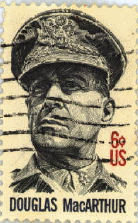The Korean War
During the final years of President Truman's term of office, events in Asia dominated America's international concerns. As a result of a World War II agreement, the United States and the Soviet Union took trusteeship possession of Korea with the 38th parallel dividing the Soviet zone in the north from the American zone in the south. In 1948, a government fashioned after the Soviet model was established in the north while the United States recognized the Republic of Korea whose government had been chosen in an election supervised by the United Nations. By mid-1949, the United States had removed the bulk of its troops. On June 25, 1950, the North Korean army crossed the 38th parallel and attacked South Korea.
An emergency meeting of the United Nations Security Council declared the attack a breach of the peace, demanded immediate withdrawal, termed North Korea an aggressor, and called upon United Nations members to furnish all possible assistance to South Korea. The United States, which felt a special responsibility toward beleaguered South Korea, quickly dispatched air and ground forces. A United Nations Command was established, and for the first time in history an organized international force was fighting aggression, although in actuality, a good 90 percent of the troops were either American or South Korean. These U.N. actions were possible because the Soviet Union's representative to the Security Council had for some time been boycotting meetings and was not present to exercise a veto.
The course of the Korean War was bitter, bloody, and
frustrating. After initial setbacks, the U.N. forces, under General
 Douglas
MacArthur, gradually took the offensive and drove the
invaders back. The end of the fighting seemed near until the
People's Republic of China put troops into action against the U.N.
forces. This intervention threatened to extend the conflict
beyond the borders of Korea. The U.N. Command, however, was
unwilling to risk sparking a far greater conflagration and so
settled upon what has been characterized as a limited war for
limited objectives.The North Koreans were eventually driven back
to a line roughly corresponding to the 38th parallel.
Douglas
MacArthur, gradually took the offensive and drove the
invaders back. The end of the fighting seemed near until the
People's Republic of China put troops into action against the U.N.
forces. This intervention threatened to extend the conflict
beyond the borders of Korea. The U.N. Command, however, was
unwilling to risk sparking a far greater conflagration and so
settled upon what has been characterized as a limited war for
limited objectives.The North Koreans were eventually driven back
to a line roughly corresponding to the 38th parallel.
After long negotiations a truce was arranged in the summer of 1953, recognizing the facts of the battlefield. By the War's end, the U.S. had sent a quarter of a million men halfway around the world and had left more than 30,000 dead soliders as testimony of its determination to oppose what it felt was aggression without due cause.
